Assignment about ICT Governance
VerifiedAdded on 2022/09/28
|11
|2235
|160
Assignment
AI Summary
Contribute Materials
Your contribution can guide someone’s learning journey. Share your
documents today.
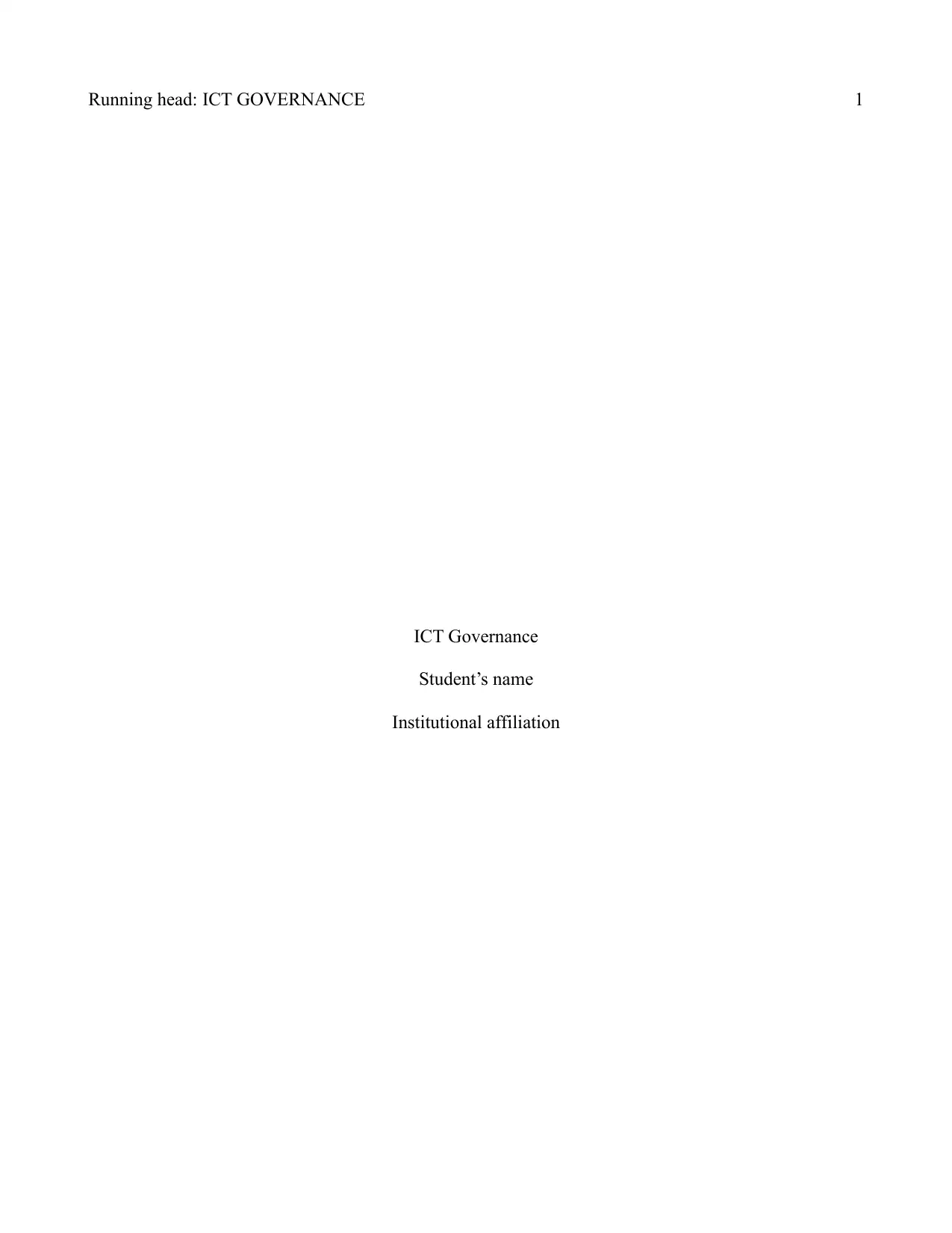
Running head: ICT GOVERNANCE 1
ICT Governance
Student’s name
Institutional affiliation
ICT Governance
Student’s name
Institutional affiliation
Secure Best Marks with AI Grader
Need help grading? Try our AI Grader for instant feedback on your assignments.
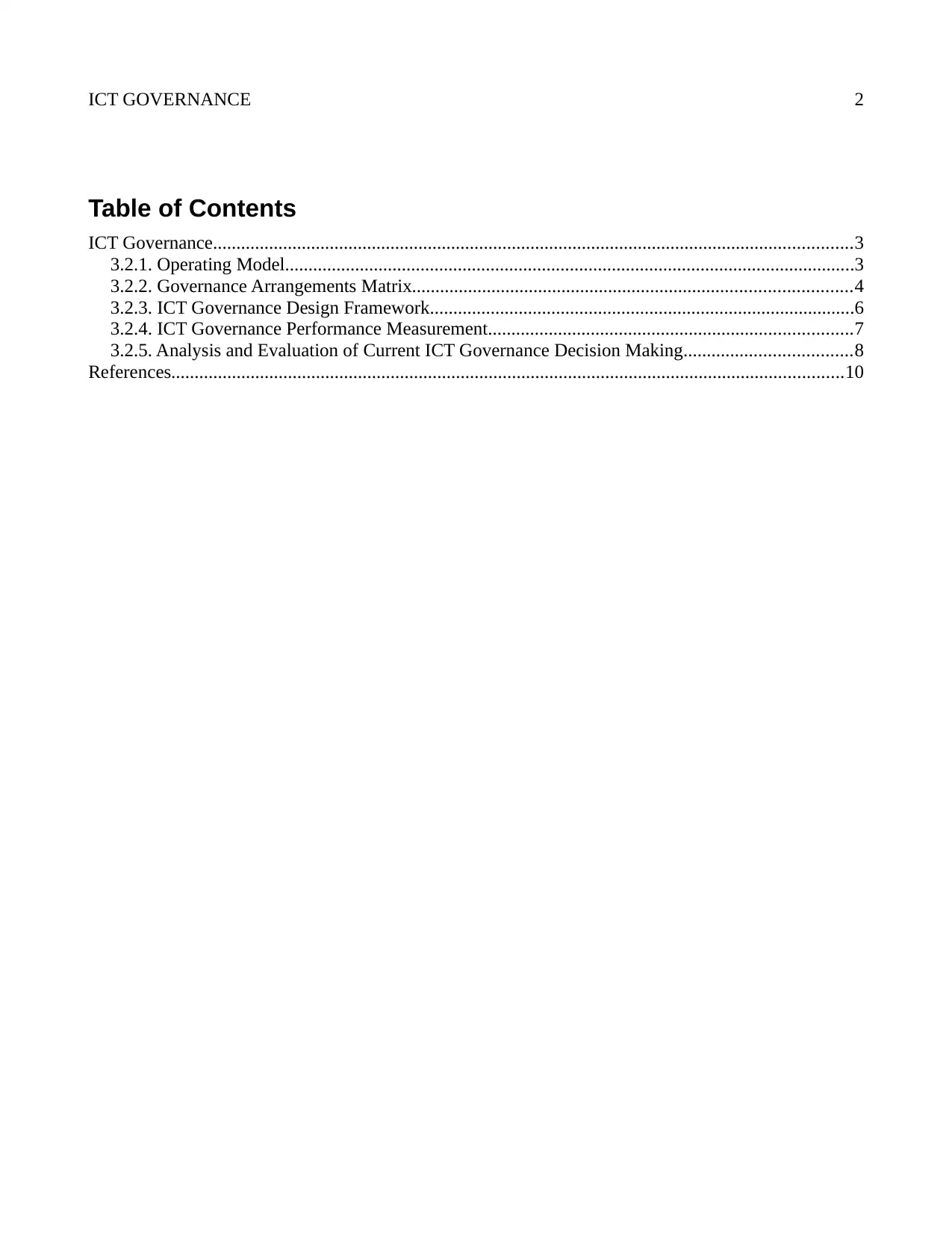
ICT GOVERNANCE 2
Table of Contents
ICT Governance.........................................................................................................................................3
3.2.1. Operating Model..........................................................................................................................3
3.2.2. Governance Arrangements Matrix..............................................................................................4
3.2.3. ICT Governance Design Framework...........................................................................................6
3.2.4. ICT Governance Performance Measurement..............................................................................7
3.2.5. Analysis and Evaluation of Current ICT Governance Decision Making....................................8
References................................................................................................................................................10
Table of Contents
ICT Governance.........................................................................................................................................3
3.2.1. Operating Model..........................................................................................................................3
3.2.2. Governance Arrangements Matrix..............................................................................................4
3.2.3. ICT Governance Design Framework...........................................................................................6
3.2.4. ICT Governance Performance Measurement..............................................................................7
3.2.5. Analysis and Evaluation of Current ICT Governance Decision Making....................................8
References................................................................................................................................................10
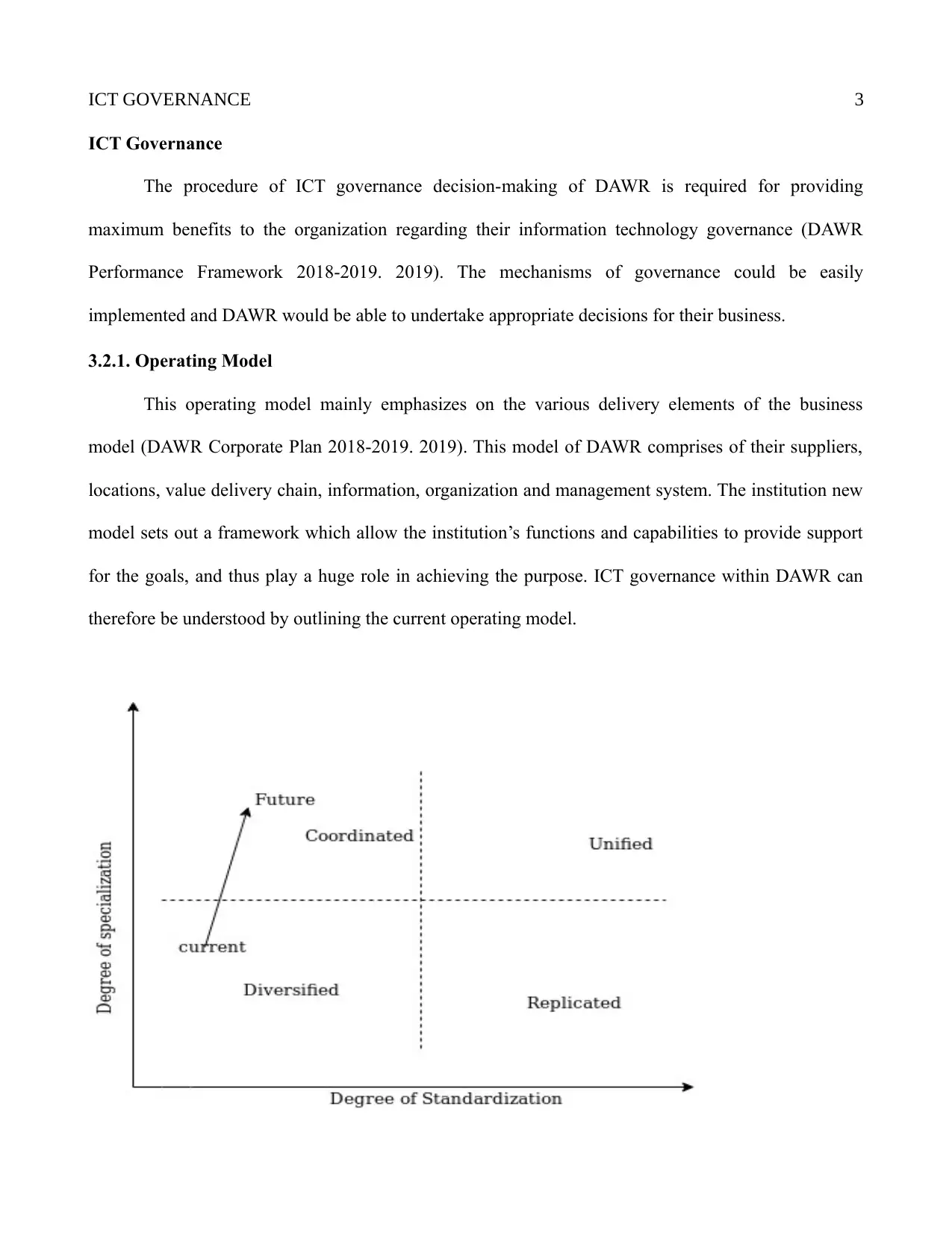
ICT GOVERNANCE 3
ICT Governance
The procedure of ICT governance decision-making of DAWR is required for providing
maximum benefits to the organization regarding their information technology governance (DAWR
Performance Framework 2018-2019. 2019). The mechanisms of governance could be easily
implemented and DAWR would be able to undertake appropriate decisions for their business.
3.2.1. Operating Model
This operating model mainly emphasizes on the various delivery elements of the business
model (DAWR Corporate Plan 2018-2019. 2019). This model of DAWR comprises of their suppliers,
locations, value delivery chain, information, organization and management system. The institution new
model sets out a framework which allow the institution’s functions and capabilities to provide support
for the goals, and thus play a huge role in achieving the purpose. ICT governance within DAWR can
therefore be understood by outlining the current operating model.
ICT Governance
The procedure of ICT governance decision-making of DAWR is required for providing
maximum benefits to the organization regarding their information technology governance (DAWR
Performance Framework 2018-2019. 2019). The mechanisms of governance could be easily
implemented and DAWR would be able to undertake appropriate decisions for their business.
3.2.1. Operating Model
This operating model mainly emphasizes on the various delivery elements of the business
model (DAWR Corporate Plan 2018-2019. 2019). This model of DAWR comprises of their suppliers,
locations, value delivery chain, information, organization and management system. The institution new
model sets out a framework which allow the institution’s functions and capabilities to provide support
for the goals, and thus play a huge role in achieving the purpose. ICT governance within DAWR can
therefore be understood by outlining the current operating model.
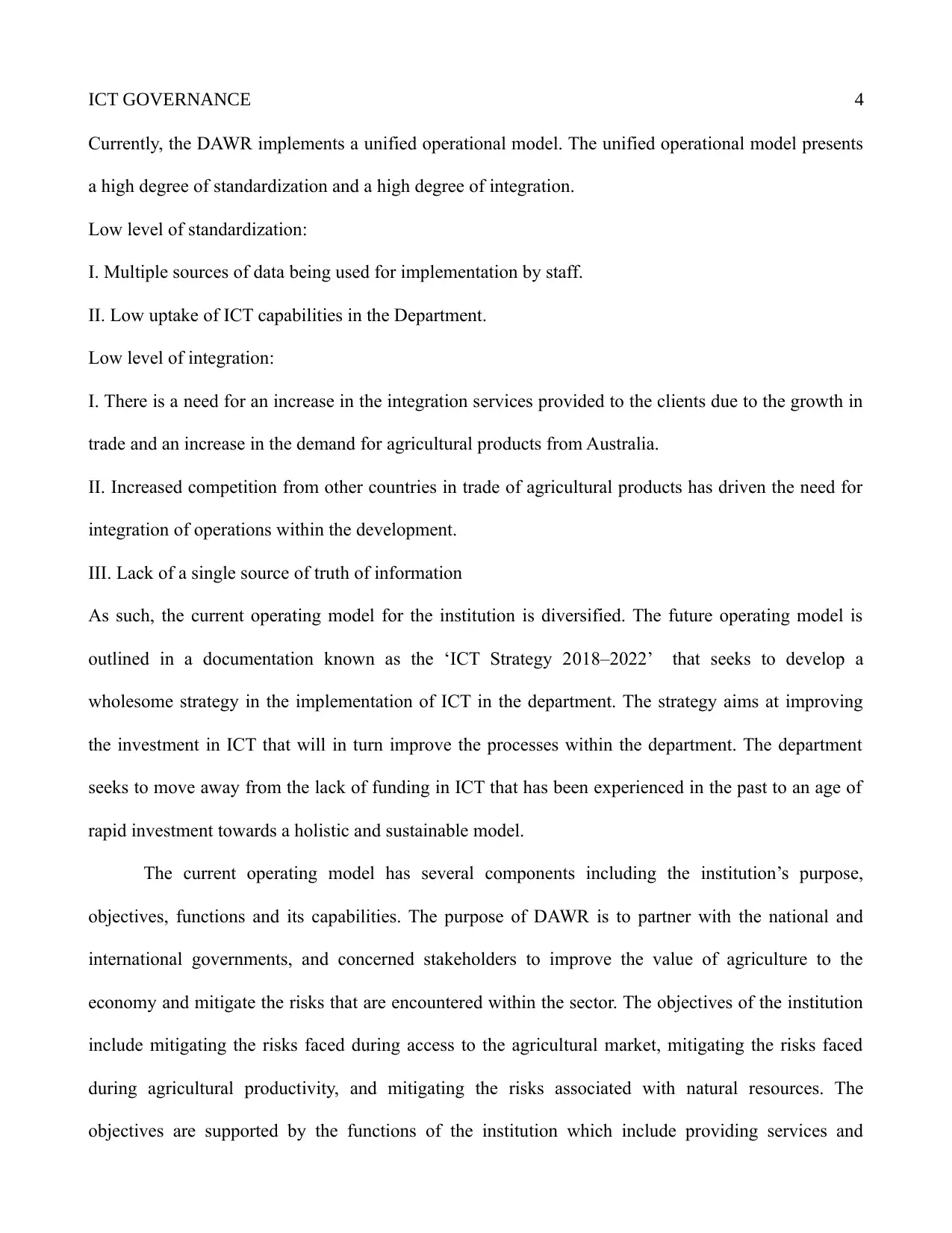
ICT GOVERNANCE 4
Currently, the DAWR implements a unified operational model. The unified operational model presents
a high degree of standardization and a high degree of integration.
Low level of standardization:
I. Multiple sources of data being used for implementation by staff.
II. Low uptake of ICT capabilities in the Department.
Low level of integration:
I. There is a need for an increase in the integration services provided to the clients due to the growth in
trade and an increase in the demand for agricultural products from Australia.
II. Increased competition from other countries in trade of agricultural products has driven the need for
integration of operations within the development.
III. Lack of a single source of truth of information
As such, the current operating model for the institution is diversified. The future operating model is
outlined in a documentation known as the ‘ICT Strategy 2018–2022’ that seeks to develop a
wholesome strategy in the implementation of ICT in the department. The strategy aims at improving
the investment in ICT that will in turn improve the processes within the department. The department
seeks to move away from the lack of funding in ICT that has been experienced in the past to an age of
rapid investment towards a holistic and sustainable model.
The current operating model has several components including the institution’s purpose,
objectives, functions and its capabilities. The purpose of DAWR is to partner with the national and
international governments, and concerned stakeholders to improve the value of agriculture to the
economy and mitigate the risks that are encountered within the sector. The objectives of the institution
include mitigating the risks faced during access to the agricultural market, mitigating the risks faced
during agricultural productivity, and mitigating the risks associated with natural resources. The
objectives are supported by the functions of the institution which include providing services and
Currently, the DAWR implements a unified operational model. The unified operational model presents
a high degree of standardization and a high degree of integration.
Low level of standardization:
I. Multiple sources of data being used for implementation by staff.
II. Low uptake of ICT capabilities in the Department.
Low level of integration:
I. There is a need for an increase in the integration services provided to the clients due to the growth in
trade and an increase in the demand for agricultural products from Australia.
II. Increased competition from other countries in trade of agricultural products has driven the need for
integration of operations within the development.
III. Lack of a single source of truth of information
As such, the current operating model for the institution is diversified. The future operating model is
outlined in a documentation known as the ‘ICT Strategy 2018–2022’ that seeks to develop a
wholesome strategy in the implementation of ICT in the department. The strategy aims at improving
the investment in ICT that will in turn improve the processes within the department. The department
seeks to move away from the lack of funding in ICT that has been experienced in the past to an age of
rapid investment towards a holistic and sustainable model.
The current operating model has several components including the institution’s purpose,
objectives, functions and its capabilities. The purpose of DAWR is to partner with the national and
international governments, and concerned stakeholders to improve the value of agriculture to the
economy and mitigate the risks that are encountered within the sector. The objectives of the institution
include mitigating the risks faced during access to the agricultural market, mitigating the risks faced
during agricultural productivity, and mitigating the risks associated with natural resources. The
objectives are supported by the functions of the institution which include providing services and
Secure Best Marks with AI Grader
Need help grading? Try our AI Grader for instant feedback on your assignments.
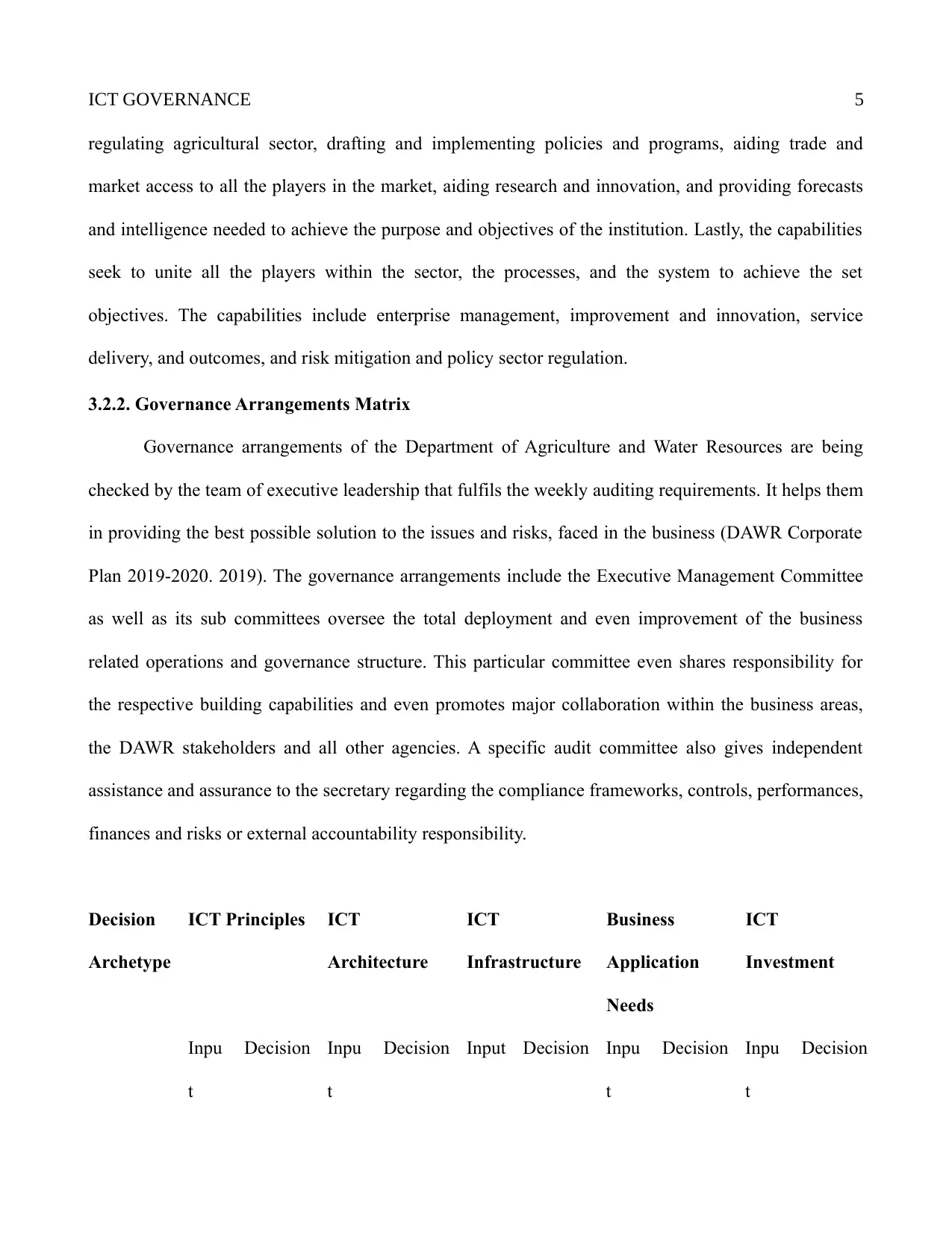
ICT GOVERNANCE 5
regulating agricultural sector, drafting and implementing policies and programs, aiding trade and
market access to all the players in the market, aiding research and innovation, and providing forecasts
and intelligence needed to achieve the purpose and objectives of the institution. Lastly, the capabilities
seek to unite all the players within the sector, the processes, and the system to achieve the set
objectives. The capabilities include enterprise management, improvement and innovation, service
delivery, and outcomes, and risk mitigation and policy sector regulation.
3.2.2. Governance Arrangements Matrix
Governance arrangements of the Department of Agriculture and Water Resources are being
checked by the team of executive leadership that fulfils the weekly auditing requirements. It helps them
in providing the best possible solution to the issues and risks, faced in the business (DAWR Corporate
Plan 2019-2020. 2019). The governance arrangements include the Executive Management Committee
as well as its sub committees oversee the total deployment and even improvement of the business
related operations and governance structure. This particular committee even shares responsibility for
the respective building capabilities and even promotes major collaboration within the business areas,
the DAWR stakeholders and all other agencies. A specific audit committee also gives independent
assistance and assurance to the secretary regarding the compliance frameworks, controls, performances,
finances and risks or external accountability responsibility.
Decision
Archetype
ICT Principles ICT
Architecture
ICT
Infrastructure
Business
Application
Needs
ICT
Investment
Inpu
t
Decision Inpu
t
Decision Input Decision Inpu
t
Decision Inpu
t
Decision
regulating agricultural sector, drafting and implementing policies and programs, aiding trade and
market access to all the players in the market, aiding research and innovation, and providing forecasts
and intelligence needed to achieve the purpose and objectives of the institution. Lastly, the capabilities
seek to unite all the players within the sector, the processes, and the system to achieve the set
objectives. The capabilities include enterprise management, improvement and innovation, service
delivery, and outcomes, and risk mitigation and policy sector regulation.
3.2.2. Governance Arrangements Matrix
Governance arrangements of the Department of Agriculture and Water Resources are being
checked by the team of executive leadership that fulfils the weekly auditing requirements. It helps them
in providing the best possible solution to the issues and risks, faced in the business (DAWR Corporate
Plan 2019-2020. 2019). The governance arrangements include the Executive Management Committee
as well as its sub committees oversee the total deployment and even improvement of the business
related operations and governance structure. This particular committee even shares responsibility for
the respective building capabilities and even promotes major collaboration within the business areas,
the DAWR stakeholders and all other agencies. A specific audit committee also gives independent
assistance and assurance to the secretary regarding the compliance frameworks, controls, performances,
finances and risks or external accountability responsibility.
Decision
Archetype
ICT Principles ICT
Architecture
ICT
Infrastructure
Business
Application
Needs
ICT
Investment
Inpu
t
Decision Inpu
t
Decision Input Decision Inpu
t
Decision Inpu
t
Decision
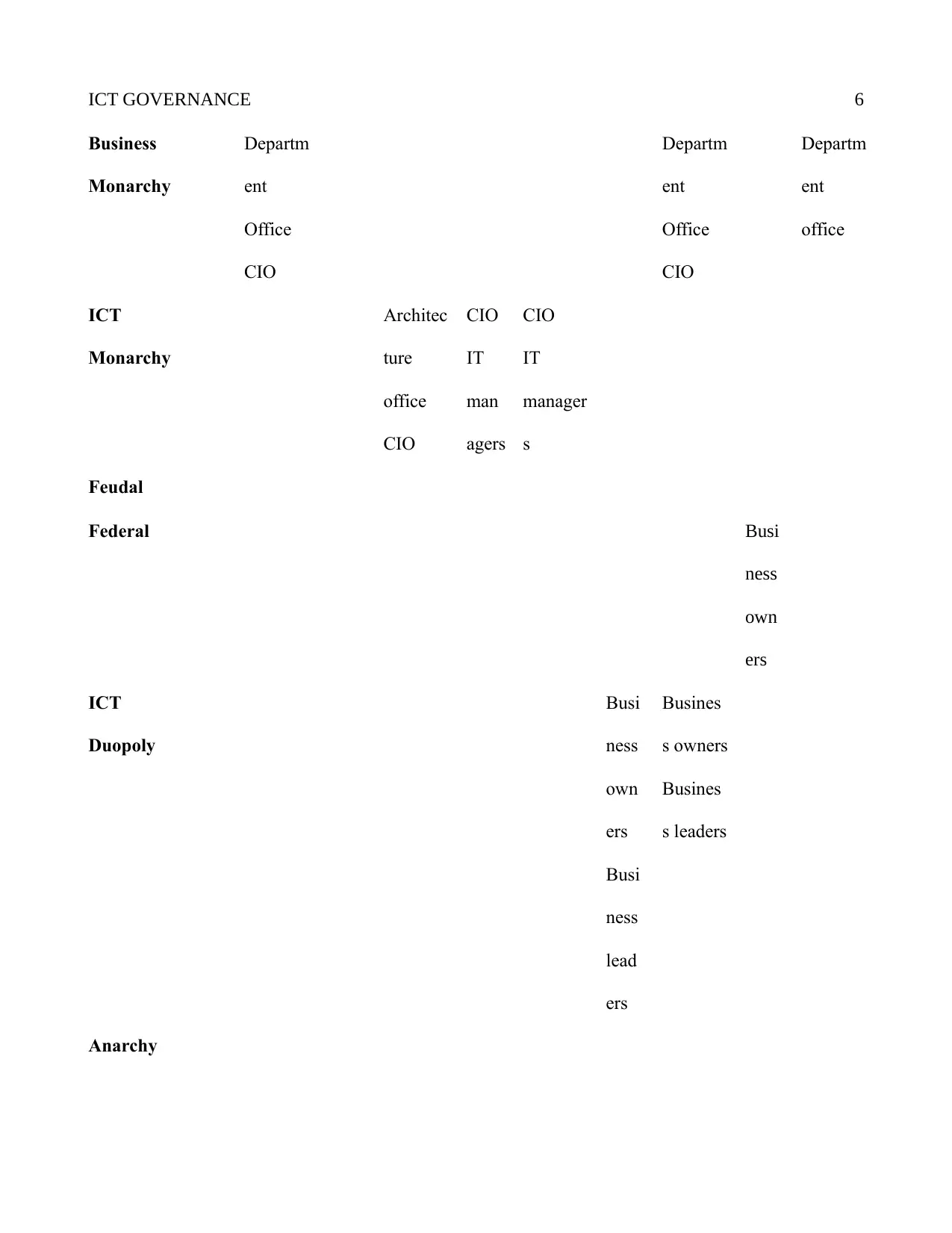
ICT GOVERNANCE 6
Business
Monarchy
Departm
ent
Office
CIO
Departm
ent
Office
CIO
Departm
ent
office
ICT
Monarchy
Architec
ture
office
CIO
CIO
IT
man
agers
CIO
IT
manager
s
Feudal
Federal Busi
ness
own
ers
ICT
Duopoly
Busi
ness
own
ers
Busi
ness
lead
ers
Busines
s owners
Busines
s leaders
Anarchy
Business
Monarchy
Departm
ent
Office
CIO
Departm
ent
Office
CIO
Departm
ent
office
ICT
Monarchy
Architec
ture
office
CIO
CIO
IT
man
agers
CIO
IT
manager
s
Feudal
Federal Busi
ness
own
ers
ICT
Duopoly
Busi
ness
own
ers
Busi
ness
lead
ers
Busines
s owners
Busines
s leaders
Anarchy
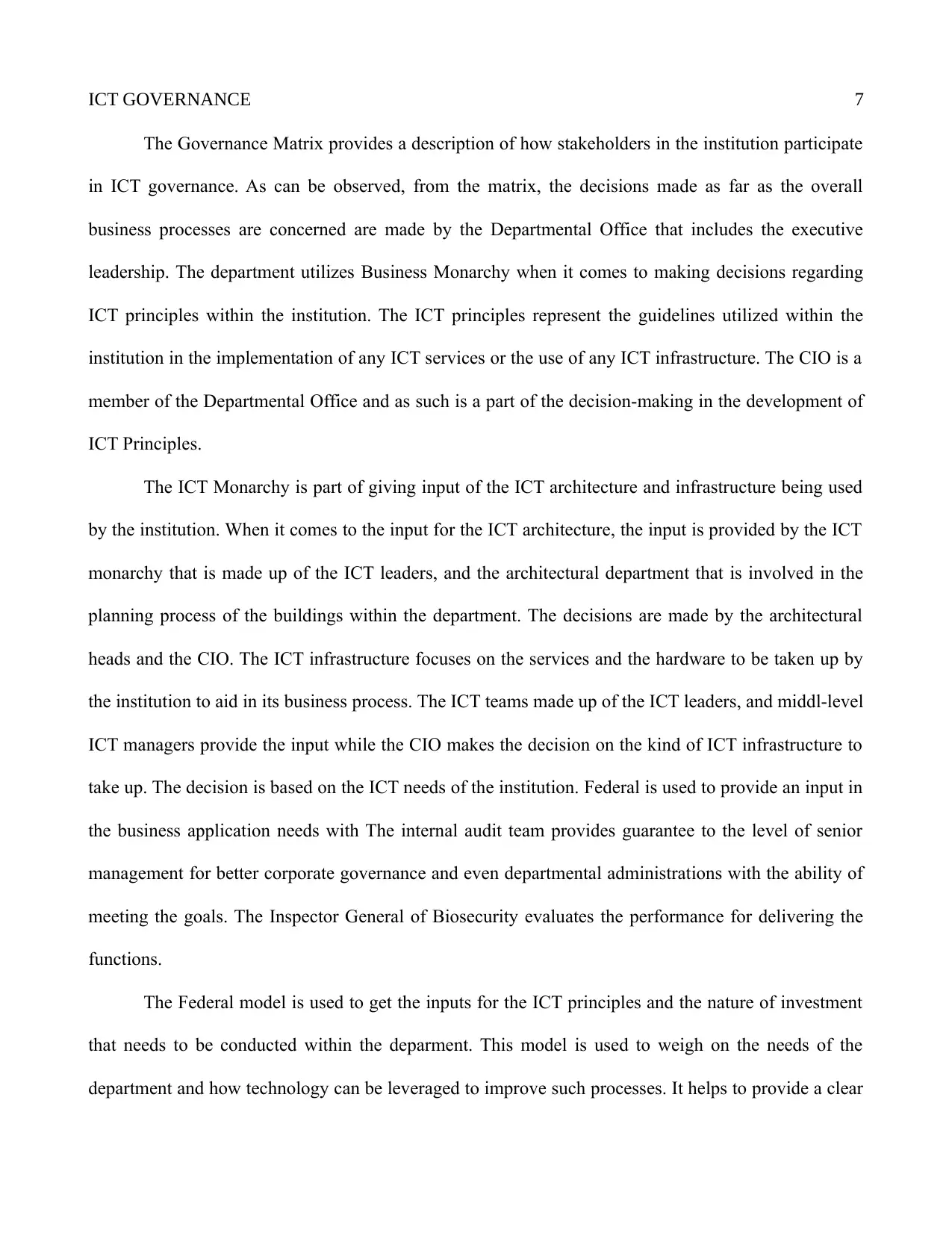
ICT GOVERNANCE 7
The Governance Matrix provides a description of how stakeholders in the institution participate
in ICT governance. As can be observed, from the matrix, the decisions made as far as the overall
business processes are concerned are made by the Departmental Office that includes the executive
leadership. The department utilizes Business Monarchy when it comes to making decisions regarding
ICT principles within the institution. The ICT principles represent the guidelines utilized within the
institution in the implementation of any ICT services or the use of any ICT infrastructure. The CIO is a
member of the Departmental Office and as such is a part of the decision-making in the development of
ICT Principles.
The ICT Monarchy is part of giving input of the ICT architecture and infrastructure being used
by the institution. When it comes to the input for the ICT architecture, the input is provided by the ICT
monarchy that is made up of the ICT leaders, and the architectural department that is involved in the
planning process of the buildings within the department. The decisions are made by the architectural
heads and the CIO. The ICT infrastructure focuses on the services and the hardware to be taken up by
the institution to aid in its business process. The ICT teams made up of the ICT leaders, and middl-level
ICT managers provide the input while the CIO makes the decision on the kind of ICT infrastructure to
take up. The decision is based on the ICT needs of the institution. Federal is used to provide an input in
the business application needs with The internal audit team provides guarantee to the level of senior
management for better corporate governance and even departmental administrations with the ability of
meeting the goals. The Inspector General of Biosecurity evaluates the performance for delivering the
functions.
The Federal model is used to get the inputs for the ICT principles and the nature of investment
that needs to be conducted within the deparment. This model is used to weigh on the needs of the
department and how technology can be leveraged to improve such processes. It helps to provide a clear
The Governance Matrix provides a description of how stakeholders in the institution participate
in ICT governance. As can be observed, from the matrix, the decisions made as far as the overall
business processes are concerned are made by the Departmental Office that includes the executive
leadership. The department utilizes Business Monarchy when it comes to making decisions regarding
ICT principles within the institution. The ICT principles represent the guidelines utilized within the
institution in the implementation of any ICT services or the use of any ICT infrastructure. The CIO is a
member of the Departmental Office and as such is a part of the decision-making in the development of
ICT Principles.
The ICT Monarchy is part of giving input of the ICT architecture and infrastructure being used
by the institution. When it comes to the input for the ICT architecture, the input is provided by the ICT
monarchy that is made up of the ICT leaders, and the architectural department that is involved in the
planning process of the buildings within the department. The decisions are made by the architectural
heads and the CIO. The ICT infrastructure focuses on the services and the hardware to be taken up by
the institution to aid in its business process. The ICT teams made up of the ICT leaders, and middl-level
ICT managers provide the input while the CIO makes the decision on the kind of ICT infrastructure to
take up. The decision is based on the ICT needs of the institution. Federal is used to provide an input in
the business application needs with The internal audit team provides guarantee to the level of senior
management for better corporate governance and even departmental administrations with the ability of
meeting the goals. The Inspector General of Biosecurity evaluates the performance for delivering the
functions.
The Federal model is used to get the inputs for the ICT principles and the nature of investment
that needs to be conducted within the deparment. This model is used to weigh on the needs of the
department and how technology can be leveraged to improve such processes. It helps to provide a clear
Paraphrase This Document
Need a fresh take? Get an instant paraphrase of this document with our AI Paraphraser
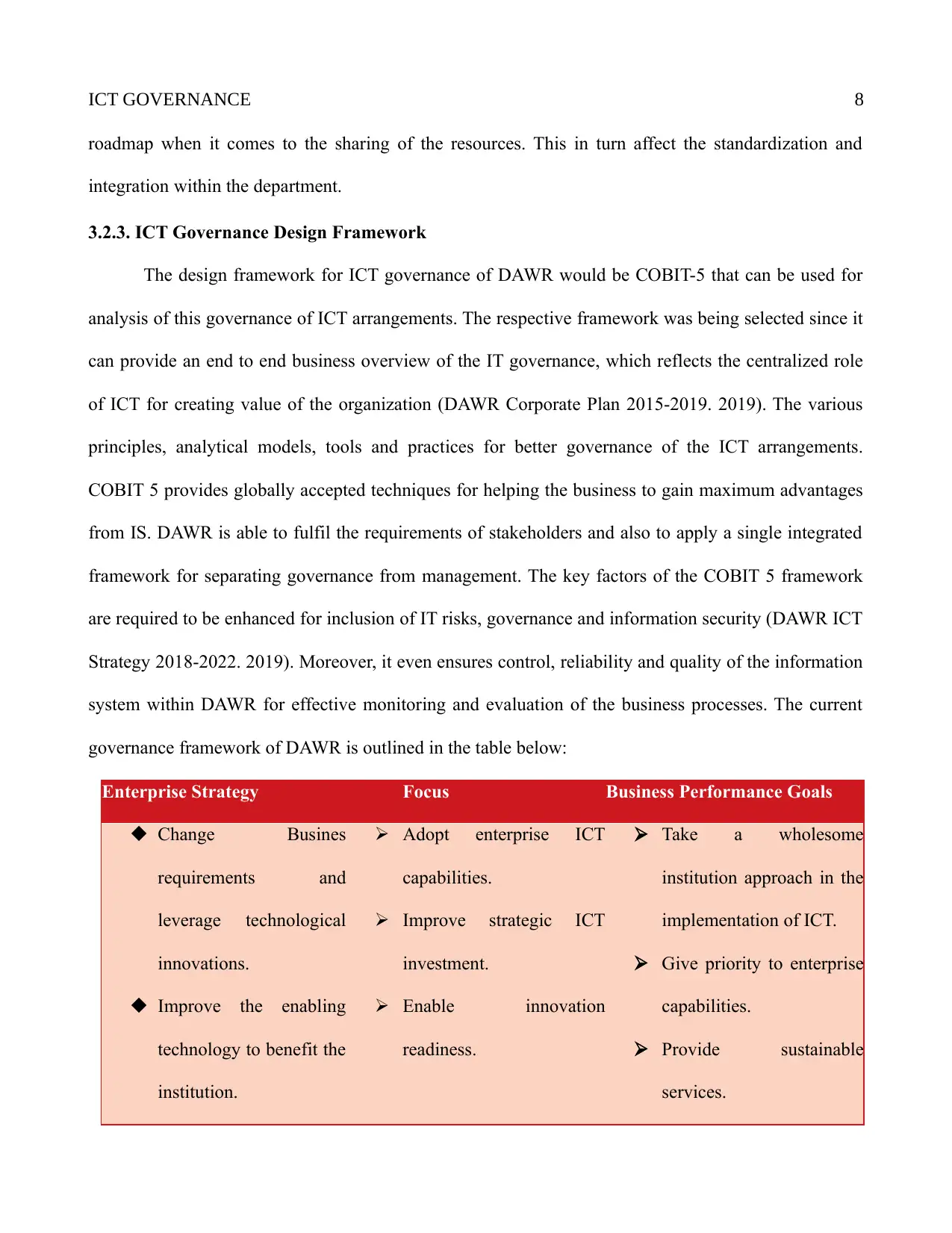
ICT GOVERNANCE 8
roadmap when it comes to the sharing of the resources. This in turn affect the standardization and
integration within the department.
3.2.3. ICT Governance Design Framework
The design framework for ICT governance of DAWR would be COBIT-5 that can be used for
analysis of this governance of ICT arrangements. The respective framework was being selected since it
can provide an end to end business overview of the IT governance, which reflects the centralized role
of ICT for creating value of the organization (DAWR Corporate Plan 2015-2019. 2019). The various
principles, analytical models, tools and practices for better governance of the ICT arrangements.
COBIT 5 provides globally accepted techniques for helping the business to gain maximum advantages
from IS. DAWR is able to fulfil the requirements of stakeholders and also to apply a single integrated
framework for separating governance from management. The key factors of the COBIT 5 framework
are required to be enhanced for inclusion of IT risks, governance and information security (DAWR ICT
Strategy 2018-2022. 2019). Moreover, it even ensures control, reliability and quality of the information
system within DAWR for effective monitoring and evaluation of the business processes. The current
governance framework of DAWR is outlined in the table below:
Enterprise Strategy Focus Business Performance Goals
Change Busines
requirements and
leverage technological
innovations.
Improve the enabling
technology to benefit the
institution.
Adopt enterprise ICT
capabilities.
Improve strategic ICT
investment.
Enable innovation
readiness.
Take a wholesome
institution approach in the
implementation of ICT.
Give priority to enterprise
capabilities.
Provide sustainable
services.
roadmap when it comes to the sharing of the resources. This in turn affect the standardization and
integration within the department.
3.2.3. ICT Governance Design Framework
The design framework for ICT governance of DAWR would be COBIT-5 that can be used for
analysis of this governance of ICT arrangements. The respective framework was being selected since it
can provide an end to end business overview of the IT governance, which reflects the centralized role
of ICT for creating value of the organization (DAWR Corporate Plan 2015-2019. 2019). The various
principles, analytical models, tools and practices for better governance of the ICT arrangements.
COBIT 5 provides globally accepted techniques for helping the business to gain maximum advantages
from IS. DAWR is able to fulfil the requirements of stakeholders and also to apply a single integrated
framework for separating governance from management. The key factors of the COBIT 5 framework
are required to be enhanced for inclusion of IT risks, governance and information security (DAWR ICT
Strategy 2018-2022. 2019). Moreover, it even ensures control, reliability and quality of the information
system within DAWR for effective monitoring and evaluation of the business processes. The current
governance framework of DAWR is outlined in the table below:
Enterprise Strategy Focus Business Performance Goals
Change Busines
requirements and
leverage technological
innovations.
Improve the enabling
technology to benefit the
institution.
Adopt enterprise ICT
capabilities.
Improve strategic ICT
investment.
Enable innovation
readiness.
Take a wholesome
institution approach in the
implementation of ICT.
Give priority to enterprise
capabilities.
Provide sustainable
services.
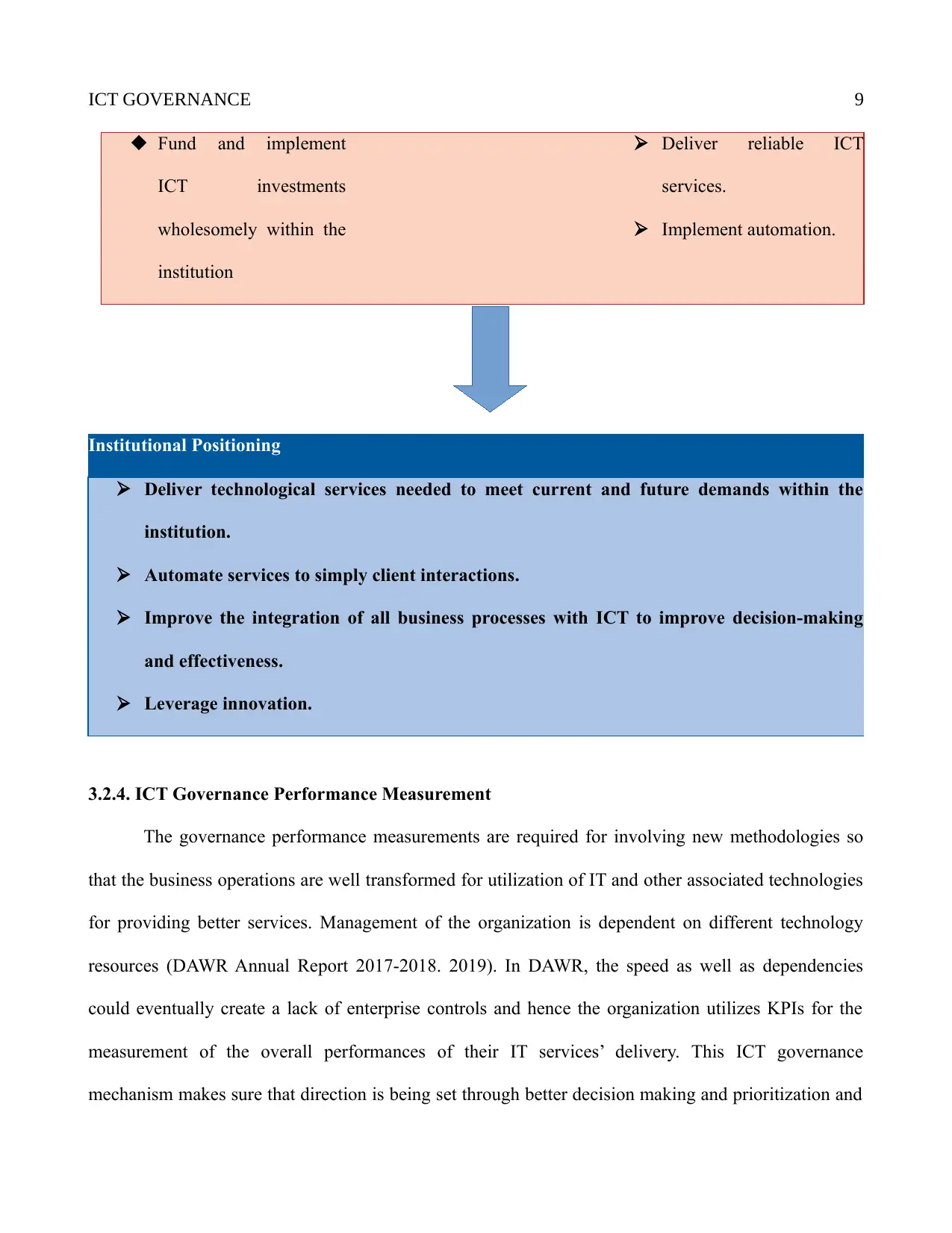
ICT GOVERNANCE 9
Fund and implement
ICT investments
wholesomely within the
institution
Deliver reliable ICT
services.
Implement automation.
Institutional Positioning
Deliver technological services needed to meet current and future demands within the
institution.
Automate services to simply client interactions.
Improve the integration of all business processes with ICT to improve decision-making
and effectiveness.
Leverage innovation.
3.2.4. ICT Governance Performance Measurement
The governance performance measurements are required for involving new methodologies so
that the business operations are well transformed for utilization of IT and other associated technologies
for providing better services. Management of the organization is dependent on different technology
resources (DAWR Annual Report 2017-2018. 2019). In DAWR, the speed as well as dependencies
could eventually create a lack of enterprise controls and hence the organization utilizes KPIs for the
measurement of the overall performances of their IT services’ delivery. This ICT governance
mechanism makes sure that direction is being set through better decision making and prioritization and
Fund and implement
ICT investments
wholesomely within the
institution
Deliver reliable ICT
services.
Implement automation.
Institutional Positioning
Deliver technological services needed to meet current and future demands within the
institution.
Automate services to simply client interactions.
Improve the integration of all business processes with ICT to improve decision-making
and effectiveness.
Leverage innovation.
3.2.4. ICT Governance Performance Measurement
The governance performance measurements are required for involving new methodologies so
that the business operations are well transformed for utilization of IT and other associated technologies
for providing better services. Management of the organization is dependent on different technology
resources (DAWR Annual Report 2017-2018. 2019). In DAWR, the speed as well as dependencies
could eventually create a lack of enterprise controls and hence the organization utilizes KPIs for the
measurement of the overall performances of their IT services’ delivery. This ICT governance
mechanism makes sure that direction is being set through better decision making and prioritization and
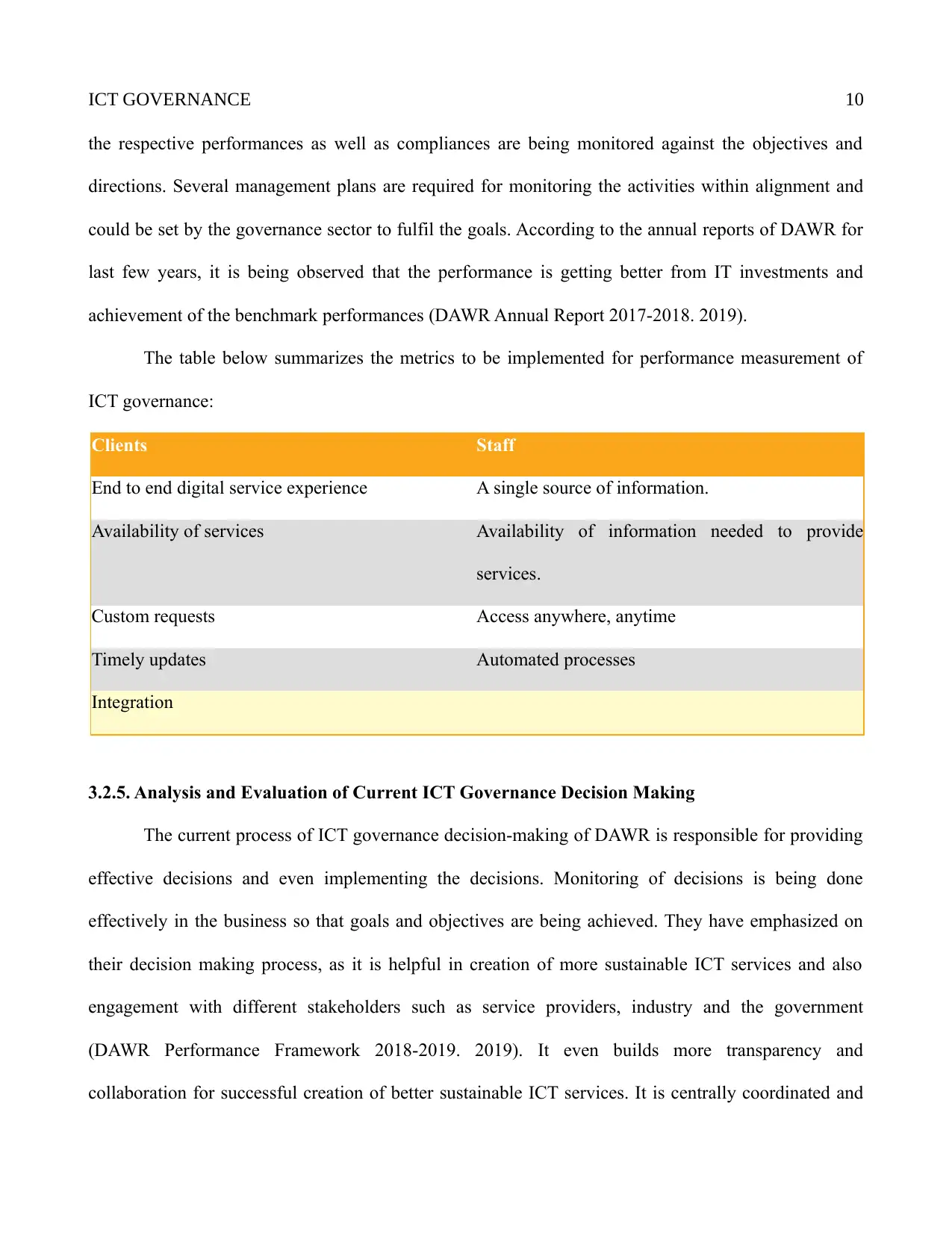
ICT GOVERNANCE 10
the respective performances as well as compliances are being monitored against the objectives and
directions. Several management plans are required for monitoring the activities within alignment and
could be set by the governance sector to fulfil the goals. According to the annual reports of DAWR for
last few years, it is being observed that the performance is getting better from IT investments and
achievement of the benchmark performances (DAWR Annual Report 2017-2018. 2019).
The table below summarizes the metrics to be implemented for performance measurement of
ICT governance:
Clients Staff
End to end digital service experience A single source of information.
Availability of services Availability of information needed to provide
services.
Custom requests Access anywhere, anytime
Timely updates Automated processes
Integration
3.2.5. Analysis and Evaluation of Current ICT Governance Decision Making
The current process of ICT governance decision-making of DAWR is responsible for providing
effective decisions and even implementing the decisions. Monitoring of decisions is being done
effectively in the business so that goals and objectives are being achieved. They have emphasized on
their decision making process, as it is helpful in creation of more sustainable ICT services and also
engagement with different stakeholders such as service providers, industry and the government
(DAWR Performance Framework 2018-2019. 2019). It even builds more transparency and
collaboration for successful creation of better sustainable ICT services. It is centrally coordinated and
the respective performances as well as compliances are being monitored against the objectives and
directions. Several management plans are required for monitoring the activities within alignment and
could be set by the governance sector to fulfil the goals. According to the annual reports of DAWR for
last few years, it is being observed that the performance is getting better from IT investments and
achievement of the benchmark performances (DAWR Annual Report 2017-2018. 2019).
The table below summarizes the metrics to be implemented for performance measurement of
ICT governance:
Clients Staff
End to end digital service experience A single source of information.
Availability of services Availability of information needed to provide
services.
Custom requests Access anywhere, anytime
Timely updates Automated processes
Integration
3.2.5. Analysis and Evaluation of Current ICT Governance Decision Making
The current process of ICT governance decision-making of DAWR is responsible for providing
effective decisions and even implementing the decisions. Monitoring of decisions is being done
effectively in the business so that goals and objectives are being achieved. They have emphasized on
their decision making process, as it is helpful in creation of more sustainable ICT services and also
engagement with different stakeholders such as service providers, industry and the government
(DAWR Performance Framework 2018-2019. 2019). It even builds more transparency and
collaboration for successful creation of better sustainable ICT services. It is centrally coordinated and
Secure Best Marks with AI Grader
Need help grading? Try our AI Grader for instant feedback on your assignments.
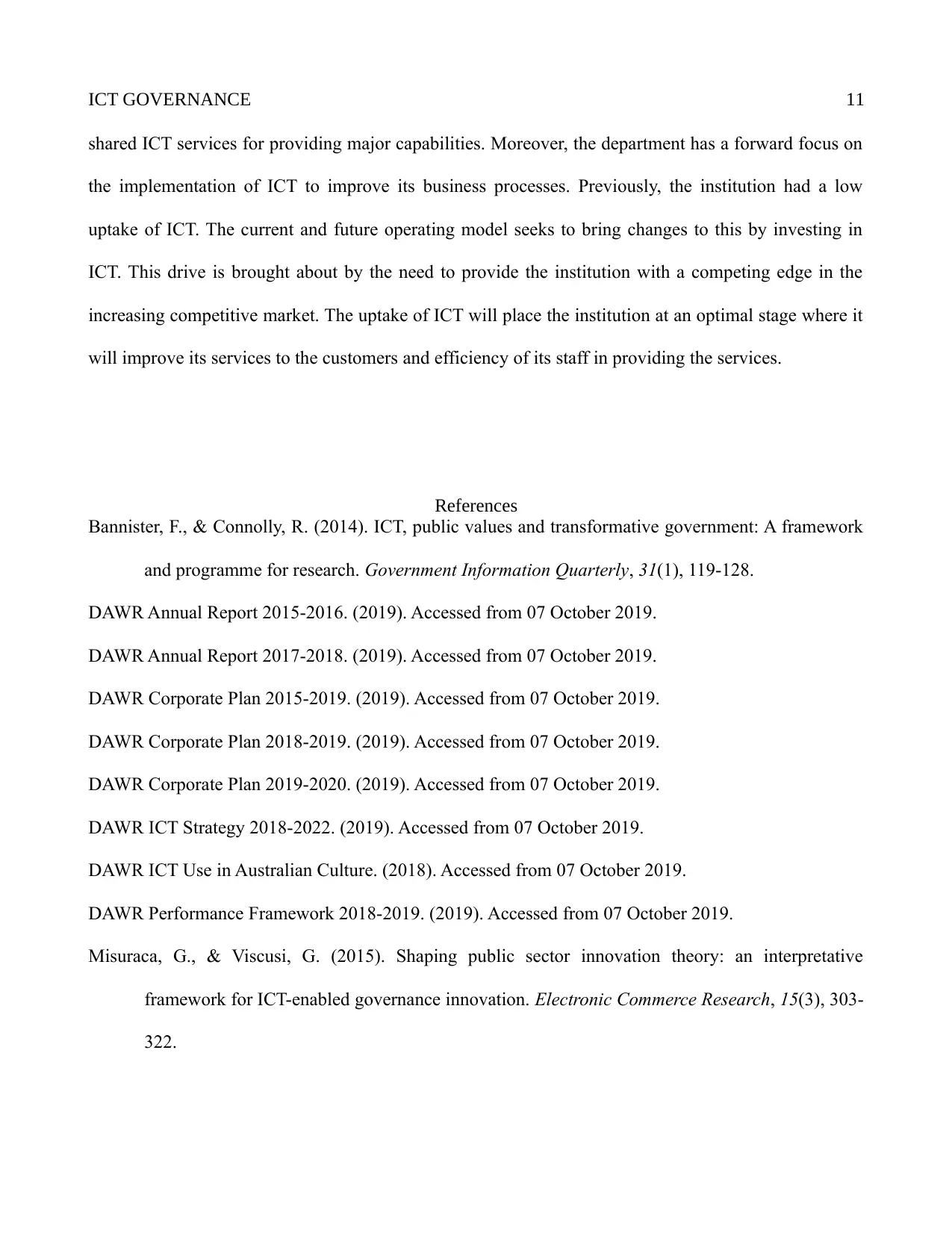
ICT GOVERNANCE 11
shared ICT services for providing major capabilities. Moreover, the department has a forward focus on
the implementation of ICT to improve its business processes. Previously, the institution had a low
uptake of ICT. The current and future operating model seeks to bring changes to this by investing in
ICT. This drive is brought about by the need to provide the institution with a competing edge in the
increasing competitive market. The uptake of ICT will place the institution at an optimal stage where it
will improve its services to the customers and efficiency of its staff in providing the services.
References
Bannister, F., & Connolly, R. (2014). ICT, public values and transformative government: A framework
and programme for research. Government Information Quarterly, 31(1), 119-128.
DAWR Annual Report 2015-2016. (2019). Accessed from 07 October 2019.
DAWR Annual Report 2017-2018. (2019). Accessed from 07 October 2019.
DAWR Corporate Plan 2015-2019. (2019). Accessed from 07 October 2019.
DAWR Corporate Plan 2018-2019. (2019). Accessed from 07 October 2019.
DAWR Corporate Plan 2019-2020. (2019). Accessed from 07 October 2019.
DAWR ICT Strategy 2018-2022. (2019). Accessed from 07 October 2019.
DAWR ICT Use in Australian Culture. (2018). Accessed from 07 October 2019.
DAWR Performance Framework 2018-2019. (2019). Accessed from 07 October 2019.
Misuraca, G., & Viscusi, G. (2015). Shaping public sector innovation theory: an interpretative
framework for ICT-enabled governance innovation. Electronic Commerce Research, 15(3), 303-
322.
shared ICT services for providing major capabilities. Moreover, the department has a forward focus on
the implementation of ICT to improve its business processes. Previously, the institution had a low
uptake of ICT. The current and future operating model seeks to bring changes to this by investing in
ICT. This drive is brought about by the need to provide the institution with a competing edge in the
increasing competitive market. The uptake of ICT will place the institution at an optimal stage where it
will improve its services to the customers and efficiency of its staff in providing the services.
References
Bannister, F., & Connolly, R. (2014). ICT, public values and transformative government: A framework
and programme for research. Government Information Quarterly, 31(1), 119-128.
DAWR Annual Report 2015-2016. (2019). Accessed from 07 October 2019.
DAWR Annual Report 2017-2018. (2019). Accessed from 07 October 2019.
DAWR Corporate Plan 2015-2019. (2019). Accessed from 07 October 2019.
DAWR Corporate Plan 2018-2019. (2019). Accessed from 07 October 2019.
DAWR Corporate Plan 2019-2020. (2019). Accessed from 07 October 2019.
DAWR ICT Strategy 2018-2022. (2019). Accessed from 07 October 2019.
DAWR ICT Use in Australian Culture. (2018). Accessed from 07 October 2019.
DAWR Performance Framework 2018-2019. (2019). Accessed from 07 October 2019.
Misuraca, G., & Viscusi, G. (2015). Shaping public sector innovation theory: an interpretative
framework for ICT-enabled governance innovation. Electronic Commerce Research, 15(3), 303-
322.
1 out of 11
Your All-in-One AI-Powered Toolkit for Academic Success.
+13062052269
info@desklib.com
Available 24*7 on WhatsApp / Email
![[object Object]](/_next/static/media/star-bottom.7253800d.svg)
Unlock your academic potential
© 2024 | Zucol Services PVT LTD | All rights reserved.
